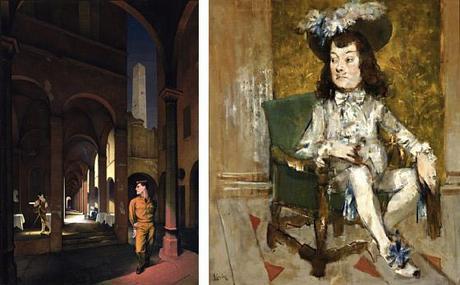This weekend the Smithsonian American Art Museum will screen two documentary films that focus on artists whose work is featured in the exhibit Modern American Realism: The Sarah Roby Foundation Collection: Jack Levine: Feast of Pure Reason, and Paul Cadmus: Enfant Terrible at 80. The director of these films, David Sutherland, will be in attendance at the screening to introduce both films and lead a Q & A with the audience.
These screenings will be on Saturday, June 28th. Jack Levine starts at 2 p.m. followed by a 30-minute intermission; Paul Cadmus begins at 4 p.m. Check out museum's calendar for more information. Programs Coordinator Alli Jessing had a few advance questions for the filmmaker.

Left: Paul Cadmus' Night in Bologna. Right: Jack Levine's The Art Lover.
Eye Level: What are we going to learn about Paul Cadmus and Jack Levine in these documentary portrait that might surprise us?
David Sutherland: Can't remember who said something like this about this about my films but on the surface, Jack Levine "provides a likeably abrasive counterpoint to Paul Cadmus' gentility, but what is surprising is that both artists are very similar in the intentions of their work" in that as social critics they both feel that "peoples noses should be rubbed in all sorts of things...pleasant and unpleasant."
EL: What was it about these artists that compelled you to tell their stories?
DS: At first, I wasn't compelled to tell Cadmus' story. I misjudged him and thought he was too passive a personality to engage a television audience. And then, I realized that he was indeed the perfect artist to act as host in a film about himself. He could demonstrate his painting and drawing techniques, put his work in historical context, knew all about art history and his times, and had a strong opinion about the world in which he lived in. He also had a great sense of humor and was a quick study who grew to understand how I was making this film about him in an elliptical way and thus was able to help me make it.
After Cadmus, I wanted a radically different personality and when I met Jack Levine I knew that he was exactly what I was looking for. One needs to remember that I am a portraitist and that entails penetrating personality, so, I was looking for a bold subject who was very different from Paul Cadmus, yet, also very able to communicate his technique, be his own art historian, and paint a finished portrait in oil of his daughter live before the camera in a day (while allowing no drying time). The temperature of his studio was, in fact, 95F/35C and if he didn't get a good likeness, he was putting his reputation on the line without a safety net. You could say that I greatly admired his boldness.
EL: Both of these artists use their works as a means of social critique. What are the pieces that you find to be most powerful, and why?
DS: Cadmus' Seven Deadly Sins say everything to me about society and satire. They will never become dated. His masterful description of each of the sins matches perfectly how he has satirically represented them in egg yolk tempera. Also, the three characters in Night in Bologna and what they want from each other is my other Cadmus favorite.
Levine's Gangster's Funeral is by far my favorite Levine satirical piece. He describes the characters in the painting, how and why he invented them, the high level view point of the painting, and all the while his delivery is sober, funny, and ironic, and one could say sort of a foreshadowing of The Sopranos. The other satirical painting of his that I like is Daley's Gesture, probably because I knew it many years before I ever knew much about Jack Levine.
EL: If you could pick any other artist to feature in a documentary, who would it be and why? DS: I saw a great film about Picasso painting a woman from behind a see through screen. Yet, Picasso didn't come across as interesting a personality as I had expected, but there was great tension in the piece, and his artistic process came across brilliantly. I also saw a very good film on Botero. After the Levine film, I began a film on Jacob Lawrence and his wife Gwen which could have been a corker, but it was not fated to happen.
Perhaps, Dali would have been the perfect subject for me. I once made a short film in grad school as an homage to Dali and Bunuel's Un Chien Andalou, my surreal film was called The Hollywood Mongrel.
EL: Are you working on any other projects that we can look forward to?
DS:DreamersDreamersEL: Thank you, and we're looking forward to Saturday!

